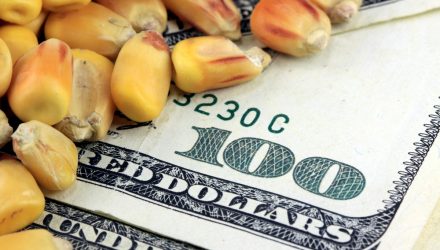As we untangle the complex commodities markets, exchange traded fund investors should explore the benefits of adding portfolio exposure to this asset class.
In the recent webcast, Inflation, Supply Chains, War: What’s Moving Commodities Markets Now, Kathy Kriskey, product strategist, Commodities and Alternatives ETFs, Invesco, highlighted the outperformance of the commodities asset class as the global economy emerged from the COVID-19 pandemic and inflation soared. Fueling the outperformance in commodities, we saw heightened inflation concerns, rising geopolitical tensions, an ongoing energy transition to combat climate change and the lingering supply-chain problems from the pandemic.
“Industry analysts advise overweighting commodities, suggesting we are in the early innings of a strong commodity cycle,” Kriskey says.
Jason Bloom, Head of Fixed Income and Alternatives ETF Product Strategy, Invesco, pointed out that the risk of above-target inflation is the most pronounced since the 1970s, with YoY Consumer Price Index at a 40-year high of 7.9% in February 2022. He notes that geopolitical risks limiting commodity supplies globally, combined with strong demand for raw materials as the global economy continues to “return to normal,” could keep inflationary pressures elevated. Meanwhile, “greenflation” could benefit commodities needed for the green energy transition, and labor shortages due to the “Great Resignation” and the rising cost of living could perpetuate wage pressure, further adding to upward inflationary pressures.
Bloom noted that commodities tend to provide greater returns than other asset classes during historic rate hike cycles. Commodity returns were largely positive when YoY CPI was greater than 2%, generating positive returns 73% of the time during rate hike cycles from 1991 through 2022. Additionally, the commodities benchmark, S&P GSCI Index, showed an average annualized return of 17.7% from 1991 through 2021, compared to the S&P 500’s 7.33% average annualized return.
Geopolitical risk remains a large support for the commodities cycle. Kriskey argued that given Russia and Ukraine’s key roles as commodity powerhouses, escalating tensions caused significant disruptions in every commodity sector, further accelerating global inflation — Russia is a major global exporter of commodities like crude oil, natural gas, coal, wheat, corn, fertilizer, aluminum, gold, and nickel.
The ongoing tensions between key market players can threaten the flow of goods, potentially driving up commodities. Russia’s invasion of Ukraine has severely impacted commodities to start 2022 and may continue to do so. Iran continues to pose a rising nuclear threat, which has limited access to the country’s crude oil on global markets. Additionally, tensions remain escalated between the U.S. and China, a leading commodity consumer and significant material producer.
Kriskey also contended that the ongoing energy transition and fight against climate change could actually be long-term bullish for commodity prices. The world’s need for affordable oil isn’t going to disappear anytime soon. If supply doesn’t pick up, that won’t bode well for any of us. Consequently, with lower support for building up fossil fuel supplies, the market is more susceptible to price volatility. A smooth energy transition will require ensuring supply reliability through continued investment in oil infrastructure, but oil companies have been reluctant to fund new, large projects and grow production due to unfavorable ESG scrutiny.
Industrial metals could also find support from the increased “green” demand growth. Kriskey pointed out that the global “net-zero” efforts should lead to higher demand for industrial metals. Metal consumption in renewables is 5-7x higher than traditional power, which can contribute to potential sustained global deficits for several years ahead.
The push for energy transition has supported demand for biofuels like ethanol, which could drive up prices for energy crops. Corn and sugar are inputs for ethanol, which may see higher prices as supply continues its struggle to meet demand.
As we look for ways to access these potential opportunities, investors can turn to something like the Invesco DB Commodity Index Tracking Fund (DBC), which seeks to track the DBIQ Optimum Yield Diversified Commodity Index Excess Return plus the interest income from the fund’s holdings of primarily U.S. Treasury securities and money market income less than the fund’s expenses.
The Invesco Optimum Yield Diversified Commodity Strategy No K-1 ETF (NasdaqGM: PDBC) is a popular, actively managed commodity ETF play. PDBC tries to negate the negative effects of contango in the commodities market by selecting future contracts with the highest implied roll yield.
For a more targeted play, the Invesco DB Agriculture Fund (DBA) is a combination of futures within several areas of agriculture, including wheat, soybeans, coffee, corn, cattle, cocoa, sugar, hogs, and cotton. It’s a smart play for investors who believe in soft commodity prices.
Additionally, the recently launched Invesco Electric Vehicle Metals Commodity Strategy No K-1 ETF (EVMT) is the first fund to offer access to upstream electric vehicle transition themes by providing exposure to commodities critical to producing electric vehicles. EVMT will invest in derivatives and other financially linked instruments to gain exposure to metals critical to electric vehicle production. These metals currently include aluminum, cobalt, copper, iron ore, nickel, and zinc.
Financial advisors who are interested in learning more about the commodities market can watch the webcast here on demand.








